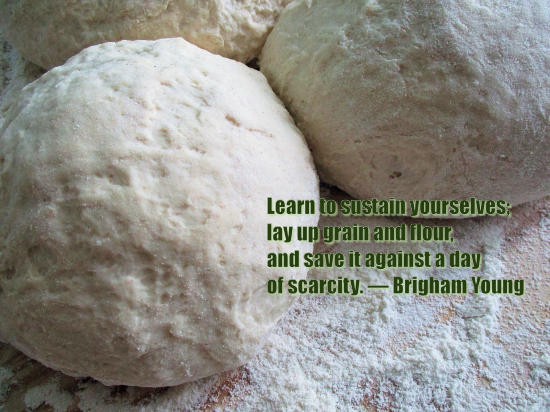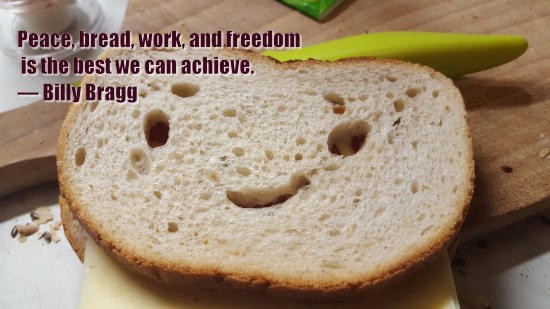Yeast is very easy to make, just capture it from the air.

Types of Yeast for Breadmaking
During this COVID-19 pandemic some people have had difficulty finding yeast in the stores. Seems people with time on their hands are taking to baking their own bread. It is definitely healthier than most of the commercial breads.
Wild yeast can be cultivated at home using simple ingredients. Once cultivated, you can dehydrate it into dry yeast if you wish or just use the the starter to make your own breads.
There are three main ways to make yeast:
- using fruits dried or fresh
- using potato water
- using other ingredients like flour or old bread
Making yeast is not an exact science. You can learn the basic ideas of how to make it, but you?ll find it?s not foolproof. If you?ve followed the basic recipe and it didn?t turn out, it?s likely something in the ingredients. Experimenting is okay. It?s how cooks have developed their abilities over the years.
Remember: It?s important to keep your yeast mixtures in a warm place. Not hot, but warm. Similar to the warmth you?d provide the dough when it?s being left to rise.
Using Fruits, Dried or Fresh
One word of caution to start. While the world is fighting this pandemic, you should be extremely cautious about using fresh fruit to make yeast. Fresh fruit is best used unwashed and unwaxed. If you?ve not grown the fruit yourself, best to leave using fresh fruit until this virus has been beaten.
Any dried fruit will produce yeast. Some will work better than others, experiment to find what works for you. It doesn?t use up much of your supplies to create yeast.
Dried fruit: grapes, raisins, prunes, apricots etc Dates work really well. The powdery stuff that you get on your fingers when you rub them is yeast.
Chlorine in your water supply will hurt the yeast production. If you are on municipal water, you may want to use bottled spring water.
- Place fruit in jar
- Add 2?3 tablespoons (30?40ml) water
- Stir the fruit around ? take note the water gets cloudy. That?s the yeast
- Add an equal amount of flour ? enough to make a loose, wet doughFlour doesn?t have to be fresh, organic, or high gluten. Any flour can be used.
- Place the mixture in a warm place.
- In about 12 hours you?ll see bubbles, let them grow.
- In about 24?48 hours the flour paste will loosen up
- Take a small amount of the mixture and add it to 2?3tbsp of water. The bubbles should popup much faster, the yeast has come to life.
If doesn?t work the first time, try again with something else.
The video below shares another approach to using fruit to create yeast:
When you?re making your bread, you can remove the fruit from the yeast mixture or leave it in.
Using Potato Water
Potato water doesn?t work as quickly as using dried fruit but in a pinch if you have potatoes in the house, you have a way of making yeast to make your bread.
This method needs only potato water, flour and sugar.
- Boil your potatoes and save the water.
- Into 1.5cups of the potato water stir 1 tablespoon of sugar and a cup of flour.
- Cover and leave this mixture in a warm place overnight. The next morning it should be bubbly and smell like yeast.
Using Other Ingredients
Other ingredients you can use to create yeast:
- old bread
- breadcrumbs
- ale
- dregs from a bottle of wine
You can create the yeast with the above ingredients following the mixing pattern with the dried fruit.

Using the Yeast You?ve Created
Unless you dry and store the yeast you?ve created, what you have is a starter. Starters need to be fed to keep them active and growing. Feeding is adding a cup each of water and flour to the yeast mix. This needs to be done daily if kept at room temperature. If you refrigerate your starter then the feeding can be done once a week.
If you?re not regularly making bread, you?ll need to remove and dispose of a cup of the starter when you feed it to keep your ratios in balance.
Now comes the tough part. How much to use when making your bread.
To start learning how to use the yeast starter, use a basic bread recipe with minimal ingredients to reduce the variables. Start by replacing one cup of your liquid with one cup of starter.
One of the differences your homemade yeast will make on your bread recipe is the time it will take to bake. Keep a check during the last 15 minutes or so on your loaf until you get a sense of how much time you need.
As I said earlier, making your yeast and bread is not an exact science. Methods can also vary. You might find another method is more comfortable for you.
Here are some resources you might find helpful:
Article: Biologist is Surprised to See Yeast Being Hoarded, Decides to Teach People How to Make it at Home This article sparked me to write this post. Well that and my friend?s writing about starting from scratch on creating her gardens. One of them had their own worms creating rich soil.
Article: How to Easily Make Your Own Yeast From Scratch This article is on a site geared to off the grid living. Some very practical suggestions in the article.
Article: Make Your Own Yeast This article has some excellent information. You may want to explore this site, The Survival Mom. It has some interesting ideas for making less do more.
Site: The Fresh Loaf Having made the plunge into making your own yeast, you may want to explore more about baking bread and the range of breads you can produce. This site is focused on the subject.

You might also enjoy:
Social Distancing Helped Me Beat Bronchitis and Will Help Beat COVID-19
Social distancing will slow the progression of the virus. Together we can make it harder to spread
medium.com
My Little Tramp is Coming Around
From feral beginnings to learning to live with her human
medium.com
Shadowspub is a writer from Ontario, Canada. She writes on a variety of subjects as she pursues her passion for learning. She sometimes needs ideas for her writing. She created Prompt A Day to share with others. You can subscribe to Prompt A Day for a set of ideas in your inbox every day.